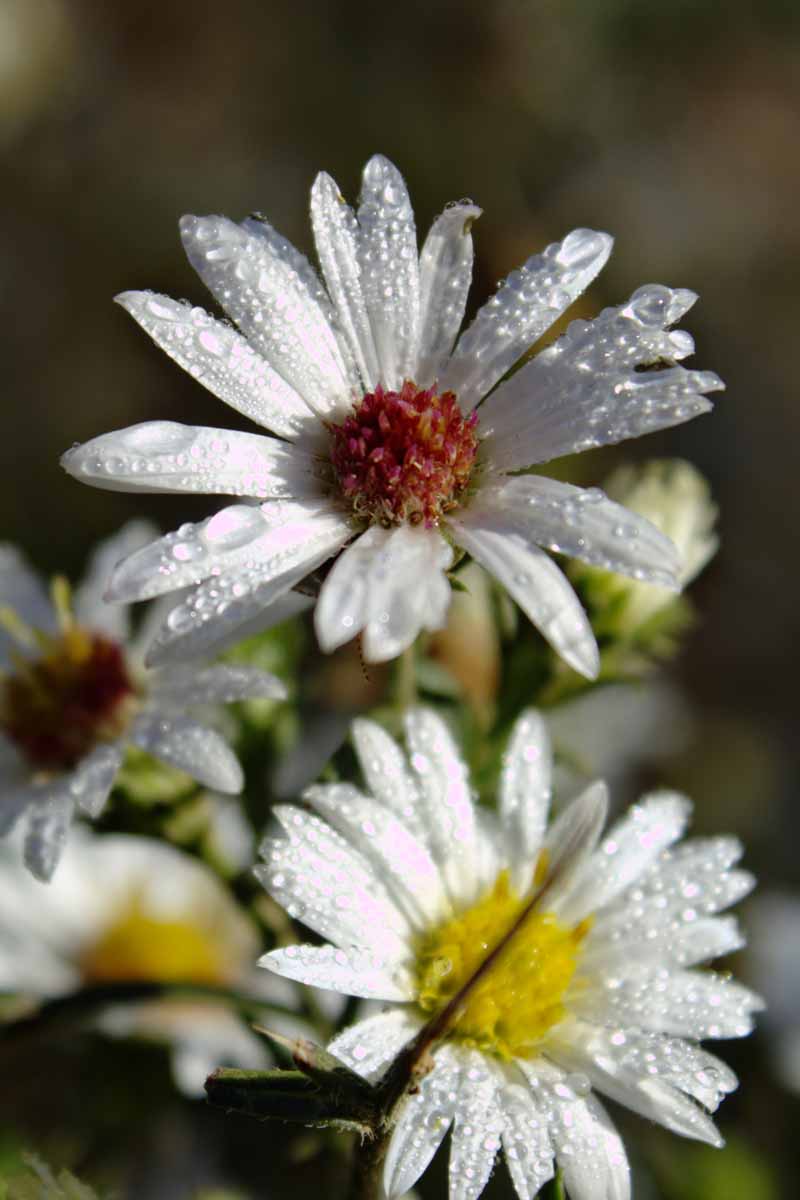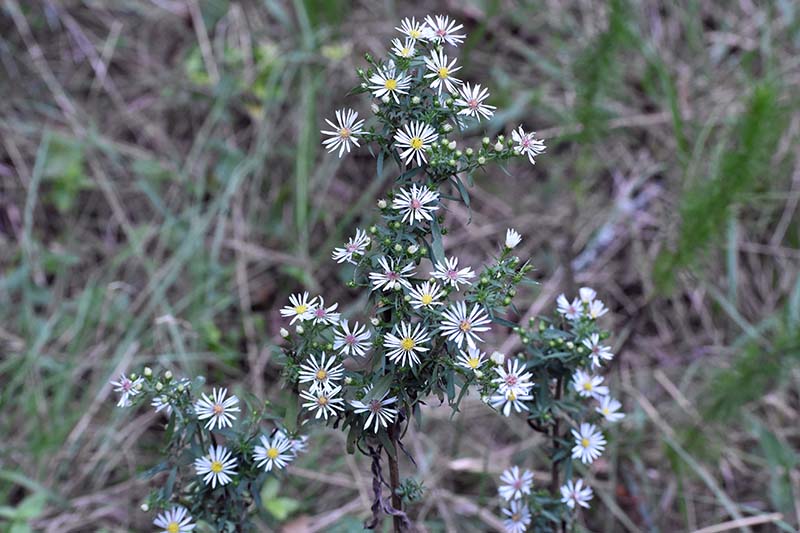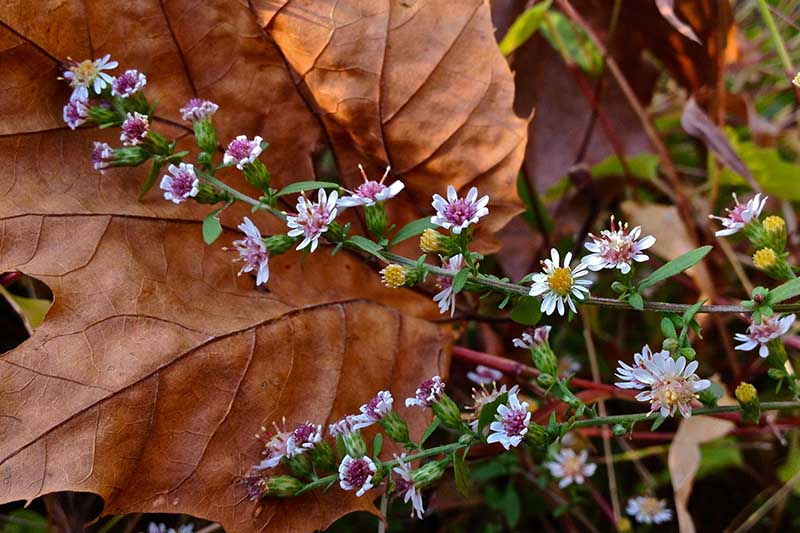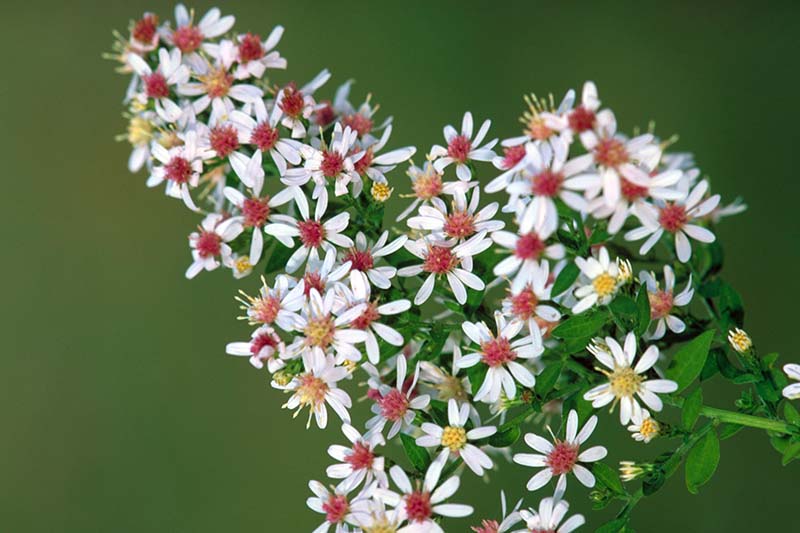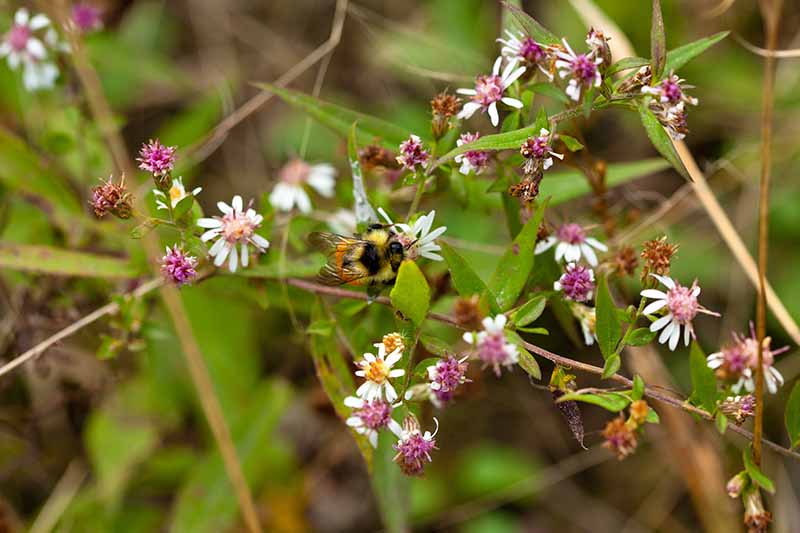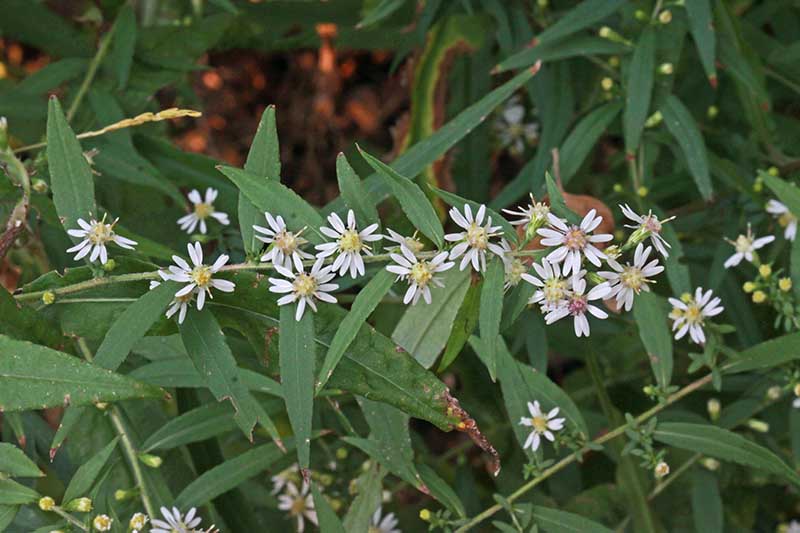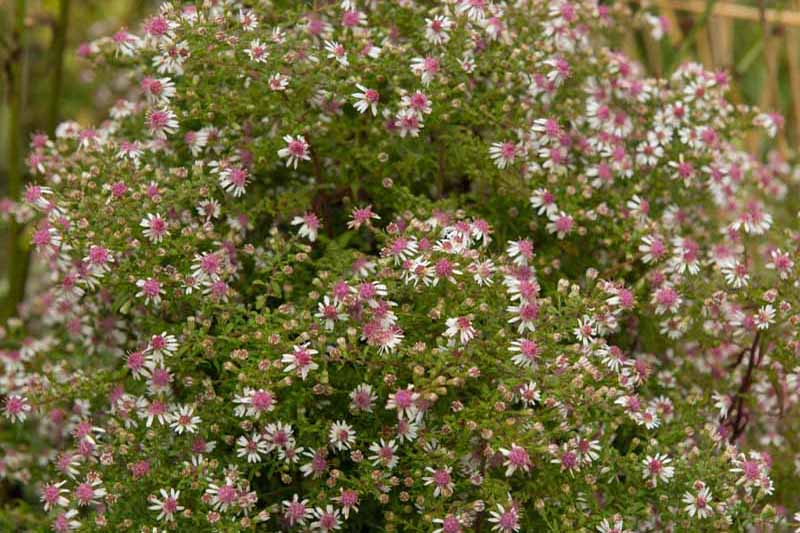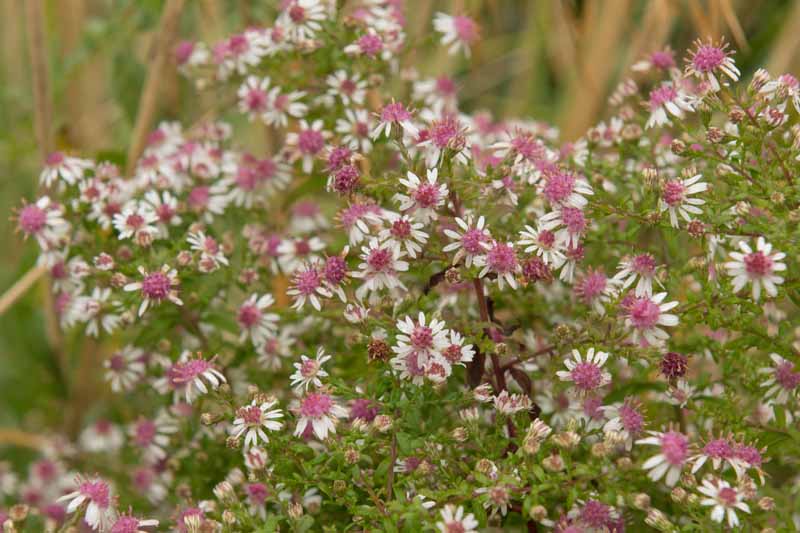It rejuvenates fall gardens with masses of tiny white blossoms, with striking reddish-purple to rosy pink centers. Suitable for gardeners in USDA Hardiness Zones 3 to 8, this plant readily naturalizes, especially in moist woodland locales, where it is virtually maintenance free. We link to vendors to help you find relevant products. If you buy from one of our links, we may earn a commission.
Cultivation and History
Also known as white woodland, starved, or side-flowering aster, the calico aster is a North American herbaceous native plant with a bushy, clumping growth habit. It grows from one to three feet tall at maturity.
The erect stems are green to brown, and hairy, with lateral branching. Tiny blossoms measuring about one-third of an inch across cluster in upright panicle fashion along the upper side of each graceful stem. They have delicate white rays and fuzzy-looking yellow centers that mature to shades of red and pink. As they don’t all mature at the same time, they have a multicolor “calico” appearance. Unlike some other asters, the nectar tubes of this type are quite short, and attract beneficial insects that have a short proboscis, like mining bees. In late fall, the flowers go to seed, turning to tufts of cottony brown and white that are dispersed by the wind to self sow. The foliage is green and narrow, with some visible serration on the largest leaves. They may be as long as four to six inches near the base of the stems, and become incrementally smaller as they approach the stem apex. There may be hairs on the underside of the leaves. In the fall, the foliage deepens to bronze tones, perfectly suited to the season. A noteworthy characteristic of this plant is that it does especially well in disturbed soil, as opposed to sites that have been untouched for long periods. Calico aster’s complete name, including the “authors” of the species, is Symphyotrichum lateriflorum (L.) A. Löve & D. Löve. Swedish botanist Linnaeus was the first to classify the species in the 1700s, and is represented by the “L.” The Löves were botanists, the first from Iceland and the second from Sweden, who fine-tuned the classification in the early 20th century.
Propagation
This plant spreads by thick rhizomes and self-sowing.
The seeds of true botanical species replicate the traits of parent plants. However, those of cultivated or hybrid varieties are unlikely to do so. Cultivars may be propagated by stem cuttings and by division. Let’s look at all three methods of propagation:
From Seed
Direct sow seed after the last average spring frost date has passed. Cover seeds with 1/8 inch of soil and maintain even moisture until they germinate. Alternatively, you can start seeds indoors about a month before the last average spring frost date. When seedlings have two sets of true leaves, harden off to gradually acclimate them to the outdoors. Set them outside for a few hours a day for three or four days. Then transplant seedlings to the garden. You may sow seed anytime from spring to fall, prior to the first frost.
From Cuttings
To take a stem cutting, use clean, sharp pruners to cut a 6 to 7-inch stem of soft, new growth in the spring or summer. Remove the leaves from the bottom three or four inches. Dip the stem in powdered rooting hormone, and place it two to three inches deep in potting medium, in a container with good drainage. Keep the rooting stem out of direct sunlight, and maintain even moisture. You can make a mini greenhouse by covering the container with a plastic bag. This promotes condensation and keeps the growing environment moist. New growth is the signal that the plant has rooted and is ready to acclimate to the outdoors, and then transplant into the garden
By Division
Another way to make new plants out of existing ones is by dividing them in the spring. See our guide to dividing perennial asters for instructions on how to dig down through the roots to remove a section for immediate transplant elsewhere.
How to Grow
The ideal location for calico aster is one that provides room for its vigorous growth habit. It should have full sun in cooler regions, and ideally, a bit of afternoon shade in warmer ones. This plant prefers organically-rich, well-draining soil, with a pH of 5.2 to 7.5. The addition of compost or leaf mulch can improve soil quality and drainage, and increase acidity. To determine if your soil is adequate, you may want to conduct a soil test through your local agricultural extension. Work the soil down about a foot until it is loose and crumbly. Amend it as needed. As mentioned above, direct sow seeds to a depth of 1/8 inch. You will need to thin seedlings to a distance of three to five feet once they have two sets of true leaves. Transplant hardened-off seedlings or stem cuttings into the soil at the same depth to which they are planted in their containers, with three to five feet between them. Maintain even moisture while they become established. Provide an inch per week, including rainfall, throughout the first growing season. At planting time, apply an all-purpose, well-balanced fertilizer such as 10-10-10 (NPK) according to package instructions. As a native plant, calico aster will not require fertilizer once it is established, unless the soil is of especially poor quality. You can also grow S. lateriflorum in containers that are at least 18 inches wide and 12 inches deep. Be sure to monitor their water needs, as containers dry out more quickly than ground soil.
Growing Tips
Growing calico aster is easy when you cater to its preferences. Here’s what you need to remember:
Provide partial shade if growing this woodland species in warmer regions. Choose a location with room for vigorous growth via extensive roots and self-sowing. Maintain an inch per week of even moisture throughout the first growing season.
Read more tips on managing perennial aster flowers here.
Maintenance
Asters are adept at fending for themselves, especially when we place them in locations that mimic their natural settings. If you have a partially-shaded wooded setting, where the soil is fertile and damp, you’re well on your way to success. As mentioned, in the first season, maintenance consists mostly of maintaining even moisture. You may pinch back the tips of the stems in early summer to create more compact plants, if desired. Every three years or so, in the spring, you may want to divide old, woody plants to invigorate them and improve airflow. Plants that are too dense invite fungal infection. If your plants become “leggy,” you may have to stake them to keep them from falling over. Some bamboo stakes and twine are all that’s needed. Leggy stems that flop over and break should be trimmed to the ground and removed, to prevent decay and invite potential pest and disease issues. Keep the growing area free from weeds that can inhibit airflow, harbor pests and disease, and compete for water and nutrients. And finally, if you like, you can collect the seeds of your asters to share with friends or save for sowing next season. Those of the true botanical species will produce clones of the parent plants. Expect varied results with seeds saved from hybrid cultivars. At season’s end, you can cut stems to the ground, or leave them in place for wildlife habitat and winter interest.
Cultivars to Select
In addition to the botanical species, there are cultivated varieties that have been bred for qualities like compact growth, exceptional disease resistance, and unusual foliage coloration.
Botanical Species Calico Aster
As found in the wild, the true botanical species is available for the home garden. Not a cultivated variety, seeds gathered will reproduce exact replicas of the parent plant. Symphyotrichum lateriflorum Mature heights are between 1 to 2 feet tall. Flowers are white with yellow centers that mature to rose pink. Each bloom measures 1/2 inch in diameter.
Horizontal Calico Aster
S. lateriflorum var. horizontalis (or horizontale) is a botanical species variety known as the horizontal calico aster. The mature height of this variety is approximately 2 feet. Unlike asters that have erect stems with protruding lateral branches, this variety has widely branching horizontal stems. The flower rays are white, or white with a hint of lavender, and the centers are rose pink. The foliage is green, and plants grow in a clumping fashion.
Lady in Black
S. lateriflorum ‘Lady in Black’ has blossoms that measure 1/2 inch in diameter, and consist of white rays with yellow centers that mature to rose pink. The stems and leaves are deep purple, and this variety grows to a mature height of between 3 and 4 feet tall. ‘Lady in Black’ Plants grow in clumps that spread widely, colonizing large areas.
Lovely
S. lateriflorum ‘Lovely’ tops out at 2 1/2 to 3 feet tall. The flowers are 1/2 inch in diameter, with rays of lavender and yellow centers that deepen to rose pink. This plant is compact and bushy, with green foliage.
Prince
‘Prince’ grows to a mature height of approximately 3 feet tall. Flowers measure 1/2 inch and have white rays and centers of deep purple-pink. The leaves and stems are dark purple like those of ‘Lady in Black,’ but this cultivar grows in small clumps, and doesn’t colonize quite so robustly.
White Lovely
‘White Lovely’ grows to a mature height of 2 to 2 1/2 feet tall. Similar to ‘Lovely,’ this cultivar has 1/2-inch flowers with white rays that are sometimes tinged with lavender. The center disks are yellow. The leaves are green and the stems may have purple markings.
Managing Pests and Disease
Native plants are not as likely to suffer from pest and disease issues as non-natives. And some cultivated varieties are bred for exceptional pest and disease resistance. However, any plant that suffers from stress is fair game for pests and disease. This is usually the result of too much or too little water. If it’s hot and dry for an extended period, a plant may become weak, and its lower leaves may turn brown and drop off. On the other hand, if the weather is especially cool and wet, the leaves may turn yellow, or chlorotic. Chlorosis can be a sign of an incurable condition called aster yellows, caused by a bacterial parasite or phytoplasma that is carried and spread by the aster leafhopper, Macrosteles quadrilineatus. The warning signs are yellow, deformed leaves and stunted growth. Affected plants should be removed to prevent the spread of this disease. Read more about how to manage aster yellows in this guide. Wet weather and a buildup of relative humidity provide the perfect setting for a fungal condition called powdery mildew. This appears as a white or gray powdery coating on the leaves, which may be treated with fungicide. It has little if any effect on the flowers. The calico species exhibits above average resistance to powdery mildew, but it is a disorder to keep in mind, particularly in damp, humid conditions. And finally, if drainage in the planting area is poor, pooling water may invite nibbling slugs and snails, and it can cause root rot. To deter pests and inhibit disease, keep in mind that the ideal distance between plants is equal to or greater than their mature width. This is generally two to four feet, as recommended. Weed regularly and divide every three years or so, to foster optimal airflow. In addition to pests and disease, herbivores may find your plants to be tasty treats. If deer and rabbits are common visitors to your yard, you may want to fence in your asters, or plant perennials like yarrow and anise hyssop near them as deterrents.
Best Uses
Calico aster spreads vigorously, so plan your garden scheme accordingly.
It makes an excellent property perimeter where it can naturalize to form a loose, informal hedgerow. Try it as a mass planting in the dappled shade of a treetop canopy. With staking, it behaves well as a texturally rich backdrop to shorter plantings in a foundation bed. Plant it with other white aster varieties, as well as coneflower, joe-pye weed, and phlox, for attractive mixed groupings. Asters are sturdy and long-lasting in both fresh and dried flower arrangements. With its profuse tiny blossoms, the calico species makes the perfect “filler” in the traditional “thriller, filler, spiller” floral design formula.
Quick Reference Growing Guide
An Informal Impact
Sometimes we tell you about compact plants with enormous flowers that earn prime garden placements as ornamental specimens. Calico aster is not this type of plant.
Instead, it’s loosely structured, with masses of tiny flowers whose strength is in the sheer number of them, and the impression they make when planted en masse. Add calico aster to your garden planner today. It’s water-wise; beneficial to local wildlife, including essential pollinators; and wired for success in native territory. If you grow this plant, please share your experience in the comments section below. Feel free to post a picture! To learn more about growing asters in your garden, you’ll need these guides next:
Grow New England Aster for Sensational Summer to Fall Color How to Grow and Care for Early-Blooming Alpine Aster How to Grow Tatarian Aster: A Dynamic Late-Season Bloomer 7 Tips for Pruning Perennial Asters



